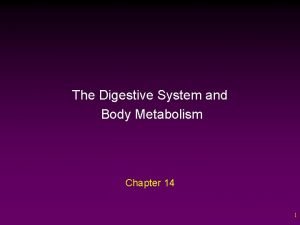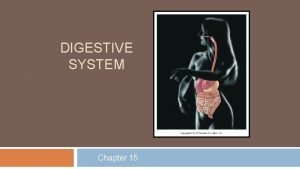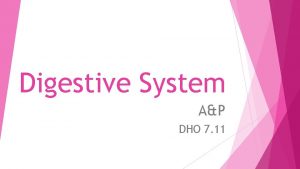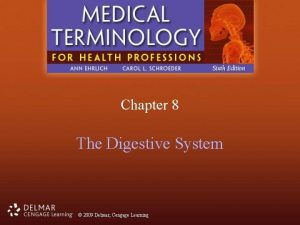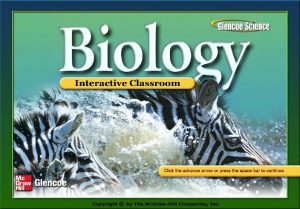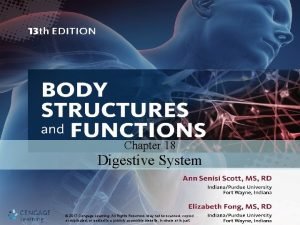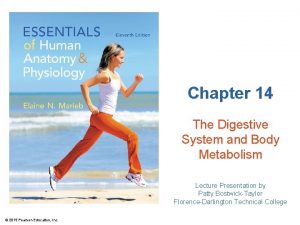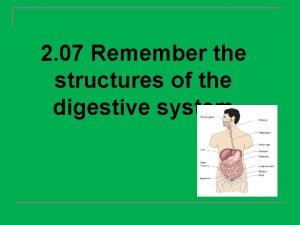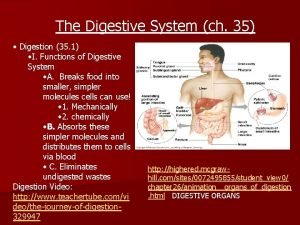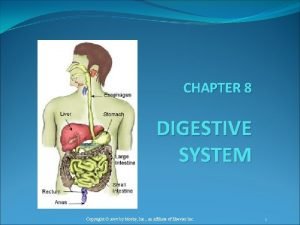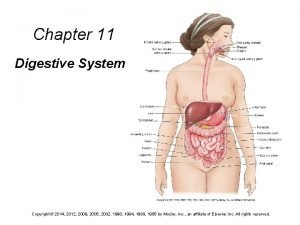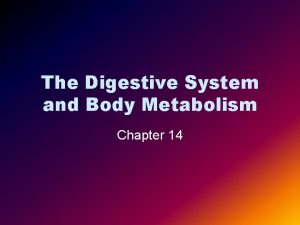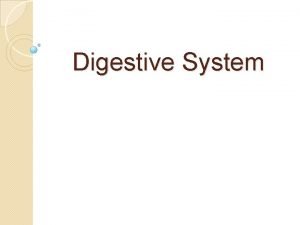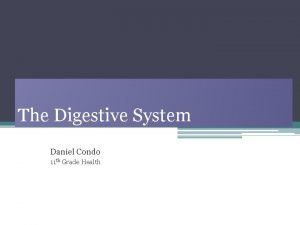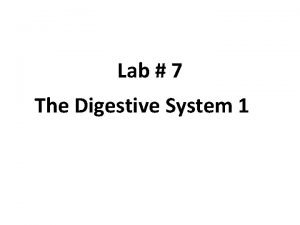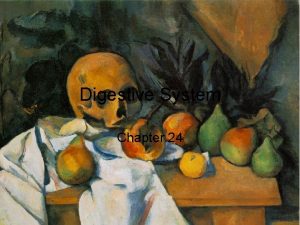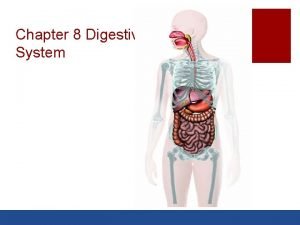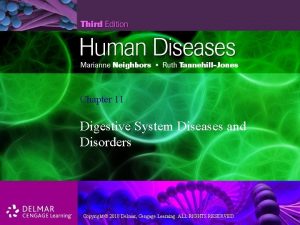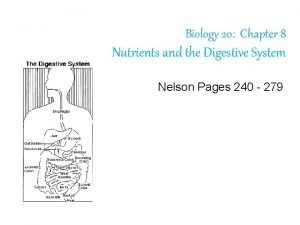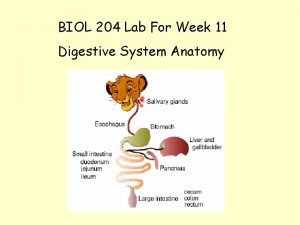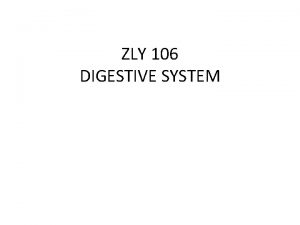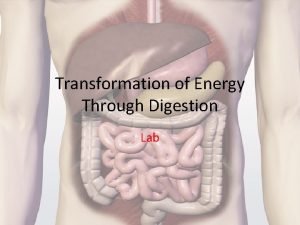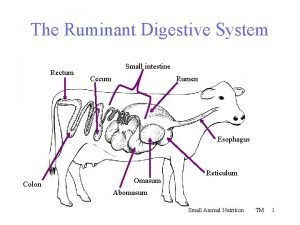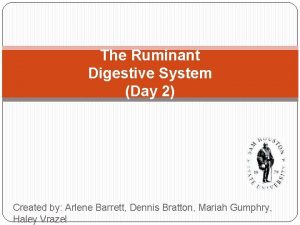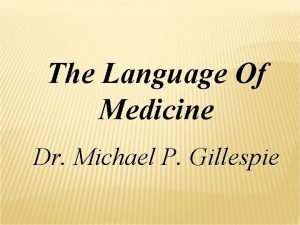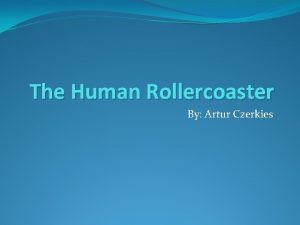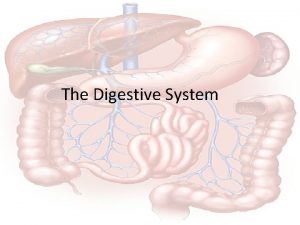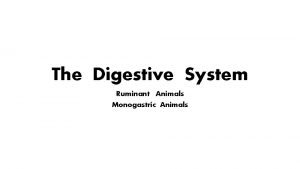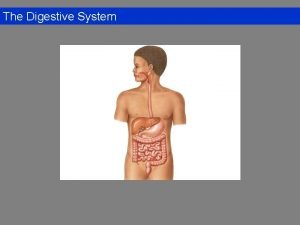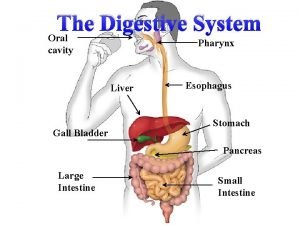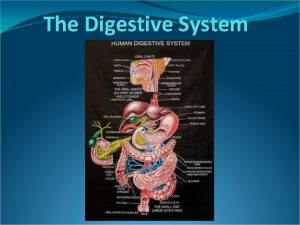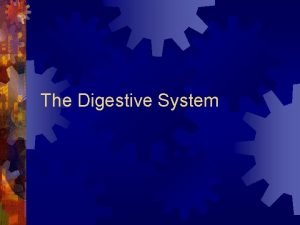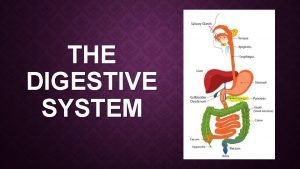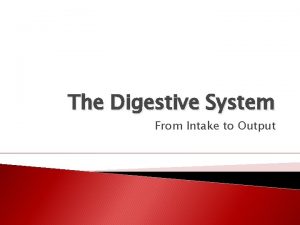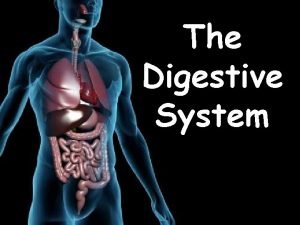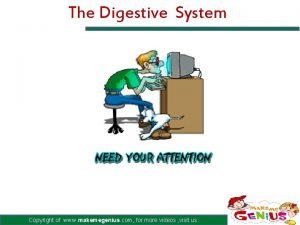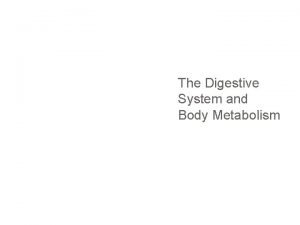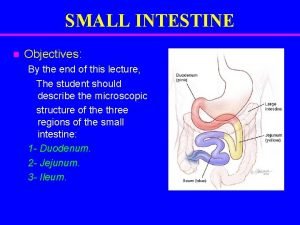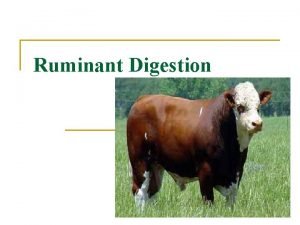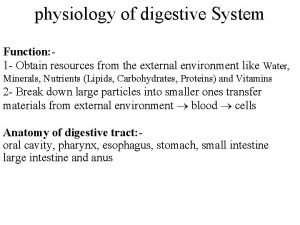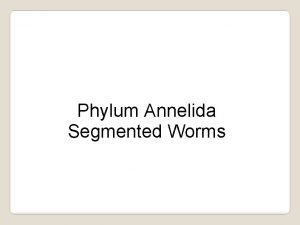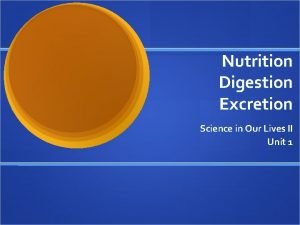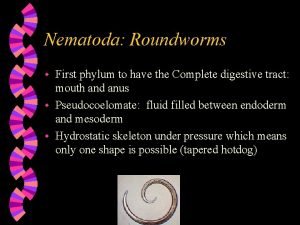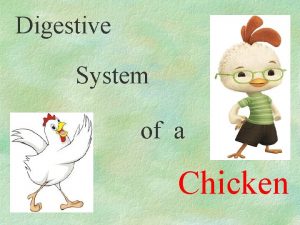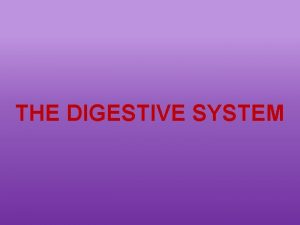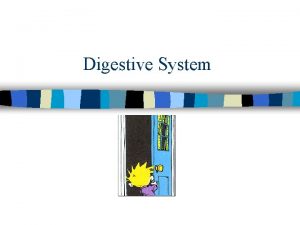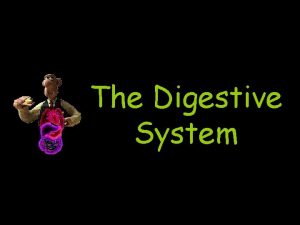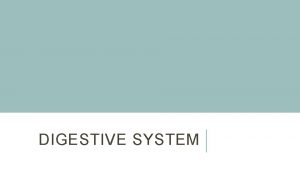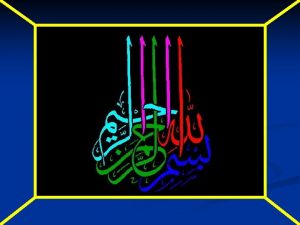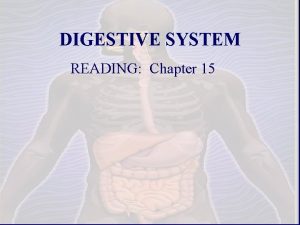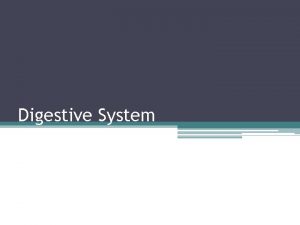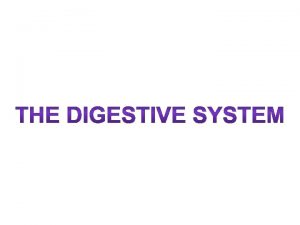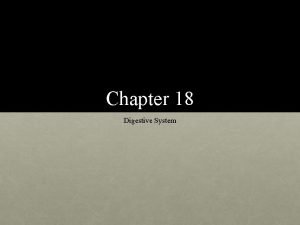DIGESTIVE SYSTEM READING Chapter 15 1 A DIGESTIVE






























































- Slides: 62

DIGESTIVE SYSTEM READING: Chapter 15 1

A) DIGESTIVE SYSTEM FUNCTIONS 1) Digestion = break food down into components for absorption: a) CHO’S simple sugars b) Protein amino acids c) Fats fatty acids and glycerol 2) Absorption of nutrients (into blood & lymph) 3) Temporary storage & elimination of wastes 4) Vitamin production in colon (bacteria) 2

B. GENERAL STRUCTURE 1) Alimentary Canal = the whole tube = approx. 30 ft. or 9 m long 2) Accessory structures that secrete into AC: salivary glands, pancreas, gallbladder, liver…. 3

B. GENERAL STRUCTURES (Fig 15. 1) Mouth (salivary glands, tongue, palate, & teeth) pharynx (throat) esophagus stomach 4 small intestine (duodenum, jejunum, ileum) large intestine anus

C. CROSS-SECTION of intestine(4 layers) 1) Mucosa -at lumen surface -produces mucous & absorbs nutrients. . . 2) submucosa -CT w/ lots of blood vessels (carry nutrients away) 3) muscularis mucosa -2 layers of smooth muscle: *inner circular *outer longitudinal -important for peristalsis (Fig 15. 3) 5

C. CROSS-SECTION (4 layers) 4) Serosa -visceral peritoneum -outermost layer -serous membrane -continuous w/ parietal peritoneum 6

Parietal Peritoneum: -lines abdominal cavity -folds in some places Fig 15. 24 7

Folds in parietal peritoneum: a) lessor omentum -attaches to lessor curvature of stomach & liver b) greater omentum -from greater curvature of stomach -lies over the intestines (like an apron) c) mesentary -anchors small intestines & prevents twisting 8

D. ORGANS 1) Mouth - cheeks and lips (Fig 15. 5) 9

2) Tongue -muscular organ important for taste, chewing, swallowing, and speech -why are taste buds important? -attached at front by frenulum (to floor of mouth) -attached at the back by _________ 10

3) Teeth - mechanical breakdown of food a) “baby teeth” = deciduous teeth or primary teeth -appear ~ 6 months and fall out ~ 6 years -dental formula = 2 -1 -2 2 incisors 1 canine (cuspid) 2 molars total = 20 teeth 11

3) Teeth b) permanent (secondary) teeth -adult dental formula = 2 -1 -2 -3 2 incisors 1 canine (cuspid) 2 premolars (bicuspid) 3 molars total = 32 teeth 12

Each type of tooth has a special function 13

3) Teeth -coated with enamel -bacteria make acid breaks down enamel dental caries (Fig 15. 9) 14

4) Salivary Glands (3 pairs in mouth) 1) parotid -biggest -near masseter muscle -saliva ducts mouth…what type of gland? 2) submandibular gland 3) sublingual 15

4) Salivary Glands -all 3 make saliva: -almost 99% H 2 O -mucous (function? ) -enzymes = salivary amylase starch Salivary amylase maltose 16

5) Pharynx -the throat -common chamber for digestion & respiration -bolus moves into pharynx when we swallow -can be divided into 3 regions…do you remember? 17

6) Esophagus -10” tube from pharynx to stomach -lined with ________epithelium -separated from stomach by cardiac sphincter -sphincter prevents acid reflux 18

• Swallowing is subconscious & conscious Bolus moves to back of pharynx Bolus touches sensory receptors Swallowing center in medulla oblongata is activated Soft palate closes nasopharynx Larynx moves up & presses epiglottis blocks trachea Vocal cords close Peristaltic wave begins to stomach 19

20

21

22

23

7) Stomach -“J” shaped organ, ~ size of a big sausage (empty) -rugae = folds (why are these folds important? ) -storage sack for food -very little absorption here (exceptions…) -cardiac sphincter at top (function…) -pyloric sphincter at bottom (function…) 24

-3 muscle layers in the stomach -alternating contractions to churn & mix chyme 25

Stomach Secretions 1) pepsin = enzyme that breaks down proteins to polypeptides 2) HCl = -creates an acidic environment (p. H = 2. 5) -pepsin works really well in an acidic environment -provides protection against pathogens 3) mucous - why is this important? 4) gastrin -hormone released when we see, smell, taste food -stimulates production of ______ & _____ -when stomach is emptied, gastrin production _____ 5) CHYME = milky paste = secretions + food 26

ULCERS -If mucous doesn’t protect stomach from pepsin & HCl -Major cause = bacterium (Helicobacter pylori) -Other contributing factors: -smoking -alcohol -stress Bleeding Ulcer = sub-mucosa has been invaded Perforated Ulcer = acid eaten all the way through (very serious, deadly) Duodenal Ulcer = in duodenum (common b/c no acid protection) -Treated with pharmaceuticals (surgery = rare) 27

28

29

30

31

8) Small Intestine (3 portions) Function = digestion & absorption of nutrients 1) Duodenum -first curve under stomach, about 12 inches long 2) Jejunum -middle portion, ~ 8 ft. long 3) Ileum -end potion, ~ 12 ft. long -ileocecal valve (flap-like) guards exit to lg. Intestine -severe vomiting = void contents of stomach & sml. intestine only What structure prevents twisting? 32

Small intestine wall is modified to increase surface area: 1) Plicae circulares = large folds 2) villi = small finger-like projections 3) microvilli = brush border on the villi 33

34

Nutrients Absorbed In Small Intestine -primary site for absorption: -simple sugars & AA’s by active transport into blood capillaries -fatty acids & glycerol by diffusion into lacteals -fat soluble vitamins (ADEK) follow fats -water absorbed by osmosis -water soluble vitamins move with water 35

Digestive Processes in Small Intestine (some enzymes are made here) Starch is broken down into maltose by what enzyme? Where? maltase Maltose glucose + glucose sucrase Sucrose glucose + fructose lactase Lactose glucose + galactose 36

More Digestive Processes in Small Intestine pepsin Protein polypeptides trypsin Polypeptides dipeptides aminopeptidase Dipeptides amino acids But, most of the digestive enzymes come from the _____ 37

9) Pancreas -next to the stomach & duodenum -has endocrine functions (hormones) & exocrine (enzymes) functions (review anatomy) 38

9) Substances made by the pancreas: (4 enzymes) a) pancreatic amylase: breaks down starch maltose b) pancreatic lipase: breaks down fats fatty acids + glycerol c) trypsin & chymotrypsin: break down polypeptides dipeptides • a) b) sodium bicarbonate (baking soda): neutralizes HCl -Where does HCl come from? -If there isn’t enough sodium bicarbonate what might happen? b) c) d) e) 39

Does the pancreas released enzymes all the time? Enzyme release is controlled by hormones made by the duodenum in response to chyme 40

What hormone regulates secretions from the stomach? Gastrin 41

Pancreatic secretions are regulated by the hormone SECRETIN 42

10) Large Intestine cecum ascending c transverse c descending c sigmoid c rectum anus Appendix attached to cecum: -lymph tissue -inflammation = appendicitis -removed surgically (why? ) 43

10) Large Intestine (structure) -unique muscularis mucosa: -circular layer = complete -longitudinal layer = incomplete haustra -NO villi in colon -lots of mucus producing goblet cells (why? ) 10) -movement = “rolling”, occasional 11) 12) 13) 14) 15) 16) 17) 44

10) Large intestine (functions) -bacteria make vitamin K -site of water & mineral absorption -collect undigested material & form feces -regulation of defecation 45

10) Large intestine (regulation of defecation) -anal canal has 2 sphincters: -internal sphincter = smooth muscle -external sphincter = skeletal muscle 46

10) Large intestine (regulation of defecation) -2 sphincters: -internal sphincter = smooth muscle -external sphincter = skeletal muscle 1. 2. 3. 4. 5. When colon is full, contractions start Reflexes from spinal cord relaxation of internal sphincter IF it’s an appropriate time, you relax external sphincter IF it’s NOT an appropriate time, contraction of external sphincter NOTE: potty training needed to learn step 4…usually at age 2 -3 IF feces stay in colon more water absorbed constipation IF feces passes quickly water isn’t absorbed diarrhea 47

Flatulence - Bacteria feed on undigested foods in colon - “flatus” = the gas produced by these bacteria - What are some foods that humans don’t digest very well? - Why is it important to include these foods in your diet? 48

Diverticula = a pouch in the wall of an organ Diverticulitis = if the pouches become inflamed 49

11) Liver (structure) -largest internal organ -4 lobes (left, right, quadrate, caudate) -2 ligaments (round and coronary) 50

Hepatic Portal Circulation (review from cardio lec. ) - blood from the capillaries in the intestines LIVER Capillaries of intestines Venules Veins Hepatic Portal Vein Venules Capillaries in liver (toxins & nutrients removed) Venules Veins Central Vein Inferior Vena Cava Heart 51

52

11) Liver (structure) Each lobe is made up of many tiny “lobules” -hepatic triad (branch of hepatic portal vein, branch of hepatic artery, bile duct) -sinusoids (vascular channels leading to central vein, lined w/ macrophages) -central vein (leads to inferior vena cave) -bile canals bile ducts hepatic duct common bile duct 53

11) Liver (functions) a) Production & Secretion of Bile -Bile contains the waste product = bilirubin (yellow-green) When is bilirubin made? -Bilirubin is usually removed from blood bile What condition develops if bilirubin accumulates in tissues? -Where does bile go once it’s made? 11) Stored in the _____________ 12) Released into the ____________ 54

When is bile released into the duodenum? -When fatty foods enter the duodenum NOTE: Does bile digest fat? 55

Why are feces brown? Biliruben (green/yellow) Duodenum (part of bile) Move through sml. intestine Colon (bacteria change color of biliruben from green to brown) Determines what? Why do infants have yellow to green feces? 56

11) Liver (other functions…see Table 15. 3) b) CHO metabolism: -stores glucose as glycogen -breaks down glycogen to glucose c) Lipid metabolism: -makes phospholipids & cholesterol -converts CHO and protein to fats d) Protein metabolism: -makes some proteins -forms urea e) Filters blood: -destroys old red blood cells (making bilirubin) f) Storage: -vitamins A, D, and B 12, glycogen, iron g) Detoxification: -removes toxins from blood -chelates heavy metals 11) 12) 57

11) Cirrhosis of the Liver -occurs when the liver can’t replace damaged tissue fast enough -healthy liver tissue is destroyed and replaced with CT -liver becomes enlarged (CT & cell division = hyperplasia) -due to alcohol, viruses, heavy metals, drugs, etc… 58

11) Hepatitis -inflammation of the liver -usually viral -5% of hepatitis carriers develop liver cancer Hepatitis A: -oral/fecal transmission -generally acute Hepatitis B: -contaminated body fluids Hepatitis C: -blood and fetal transmission -responsible for 50% of all hepatitis cases -chronic symptoms in 60% of all sufferers Hepatitis D: Hepatitis E: 59

12) Gall bladder -storage site for bile made in the liver -bile in gall bladder cystic duct common bile duct duodenum -when does the gall bladder contract? 60

CCK is a hormones that regulates bile release into duodenum 61

12) “gall stones” or “bile stones” - Form when bile is too concentrated 62
 While reading activities
While reading activities Digestive system circulatory system and respiratory system
Digestive system circulatory system and respiratory system Nervous system and digestive system
Nervous system and digestive system Figure 14-1 is a frontal view of the digestive system
Figure 14-1 is a frontal view of the digestive system Gastric secretions
Gastric secretions Chapter 7:11 digestive system diagram
Chapter 7:11 digestive system diagram Cengage chapter 8 answers
Cengage chapter 8 answers Chapter 35 section 1 the digestive system
Chapter 35 section 1 the digestive system Chapter 18 digestive system
Chapter 18 digestive system Chapter 14 digestive system and body metabolism
Chapter 14 digestive system and body metabolism Chapter 7:11 digestive system labeling
Chapter 7:11 digestive system labeling Chapter 35 section 1 the digestive system answer key
Chapter 35 section 1 the digestive system answer key Chapter 8 the digestive system
Chapter 8 the digestive system Anatomy and physiology coloring workbook chapter 14
Anatomy and physiology coloring workbook chapter 14 Chapter 7:11 digestive system
Chapter 7:11 digestive system Digestive system and body metabolism
Digestive system and body metabolism Study the digestive maze below
Study the digestive maze below Chapter 7:11 digestive system
Chapter 7:11 digestive system On digestion
On digestion Blade shaped teeth that function in cutting
Blade shaped teeth that function in cutting Big mac matrix
Big mac matrix Chapter 24 the digestive system
Chapter 24 the digestive system Pharynge
Pharynge Chapter 7:11 digestive system
Chapter 7:11 digestive system Chapter 8 the digestive system
Chapter 8 the digestive system Chapter 7:11 digestive system
Chapter 7:11 digestive system St. louis
St. louis What are the aims of teaching reading
What are the aims of teaching reading Intensive reading characteristics
Intensive reading characteristics Reading strategies edb
Reading strategies edb Reading is an active process
Reading is an active process Real definition of extensive reading
Real definition of extensive reading Intensive reading and extensive reading
Intensive reading and extensive reading Reading techniques and strategies
Reading techniques and strategies Sheep digestive system
Sheep digestive system What is this
What is this Digestive system energy transformation
Digestive system energy transformation Digestive system of ruminant
Digestive system of ruminant Sheep digestive system
Sheep digestive system Ruminants fourth stomach
Ruminants fourth stomach øhuman digestive system
øhuman digestive system Digestive system roller coaster project
Digestive system roller coaster project Human digestive system facts
Human digestive system facts Monogastric animal
Monogastric animal Serosa vs adventitia
Serosa vs adventitia Duodenum function
Duodenum function Introduction to digestive system
Introduction to digestive system Plicae digestive system
Plicae digestive system Pepto bysmol
Pepto bysmol What are the outputs of the digestive system
What are the outputs of the digestive system Intestine
Intestine Egestion vs excretion
Egestion vs excretion Www.makemegenius.com digestive system
Www.makemegenius.com digestive system Figure 14-1 digestive system
Figure 14-1 digestive system Biggest muscle in human body
Biggest muscle in human body M cells
M cells What animal is this
What animal is this Snake heart
Snake heart Dissected frog diagram
Dissected frog diagram Ctenophora
Ctenophora Segmented worms definition
Segmented worms definition Digestive system order
Digestive system order First phylum with complete digestive system
First phylum with complete digestive system



